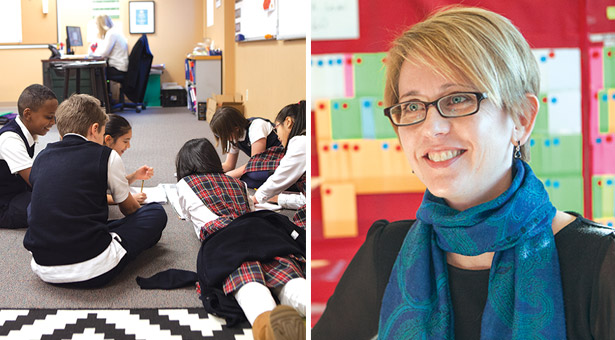The City Urban Perspectives
SPU Education Faculty Give Schools Tools for Teacher Collaboration
Professional Learning Communities
By Zachariah Bryan ’11 | Photos by Luke Rutan
 Students at Northshore Christian have benefited from SPU-led teacher collaborations,
which include the “assessment wall,” (right) a color-coded chart that tracks student
performance, pictured here with Northshore staff member Janet Christy MEd ’95.
Students at Northshore Christian have benefited from SPU-led teacher collaborations,
which include the “assessment wall,” (right) a color-coded chart that tracks student
performance, pictured here with Northshore staff member Janet Christy MEd ’95.
The idea isn’t especially new or groundbreaking. It isn’t even that complicated. But the Seattle Pacific University School of Education is helping to transform the way schools around Washington state do their business.
The idea is this: allotting time for teachers to talk to and collaborate with each other around student learning. Assistant DeanDan Bishop calls it “Professional Learning Communities,” or PLC for short. This year, Bishop and the SOE has been awarded a contract from the Washington State Office of the Superintendent of Public Instruction to evaluate the implementation of PLCs at about 95 public schools and districts throughout the state, a project funded by the Bill and Melinda Gates Foundation.
“In some ways, the beauty of it is it’s pretty simple, it’s pretty straightforward,” Bishop says. “The idea is that as a community we collaboratively look at what we want students to know and be able to do. We pull together so we can sharpen each other.”
It might sound like a nobrainer, but pulling teachers out of their classrooms can be harder than it sounds.
“It’s difficult to break down those cultural norms of how teaching and learning works, to move a school or school system from what has traditionally been teaching in isolation,” Bishop says.
The idea is to shift teachers’ thinking from, “Those are your kids, these are my kids, you take care of your kids and I’ll take care of mine,” to “These are all of our kids” and “All the kids here are part of our responsibility.” To do this, Bishop said, involves consistent, small increments that subtly change the way teachers learn and teach. In this case, a meeting between a group of teachers every week or so. (The size and frequency of the group meetings varies from school to school.)
“You can’t do it all. You have to rely on each other to support each other — sharing ideas, sharing thoughts, sharing challenges, asking for help — it takes a whole shift in confidence in your colleagues,” Bishop says.
Bishop knows the method is successful, because about two years ago he finished up a previous grant from the Murdock Charitable Trust, which created a five-year process of introducing PLCs to several Christian schools in Washington.
At Northshore Christian Academy, a school of over 950 students located in Everett, teachers and educational leaders have been participating in PLCs for seven years — five years under the guidance of Jan Brown, SPU professional education program associate, and two years independently.
“It’s completely changed the way we do things around here now,” says Jeff Culp, principal of 3–5 and STEM education coordinator. Before, introducing new ideas was a bit more haphazard. If a principal wanted to try something, he or she would have to find a teacher who would be willing to take it on, and then hope that it would just “catch on.” It was a top-down management style that worked well enough, he says, though it wasn’t always efficient.
With PLCs, teachers have time to discuss ideas and are able to spread them much faster. Furthermore, they are able to cast their own visions and, at times, strike something brilliant. It gives teachers the ability to manage themselves.
And SPU’s push to spread PLCs has already gone beyond Washington state. In September, Bishop and Rick Eigenbrood, dean of SPU’s School of Education were in China, presenting the idea at a conference for teachers in international schools. The response?
“Gao-da-shang.”
In English, it might translate to, “high end, premium quality.”
